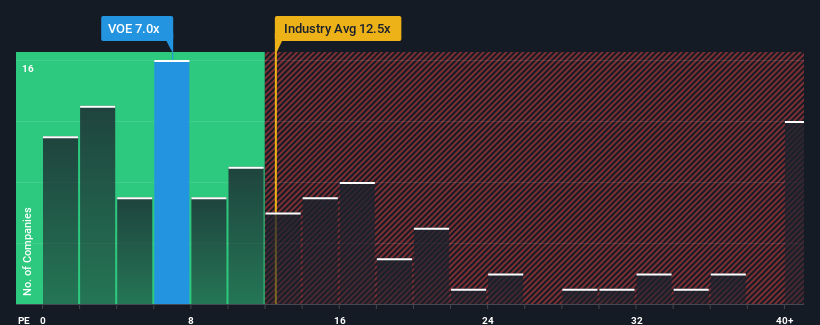
Voestalpine AG's (VIE:VOE) price-to-earnings (or "P/E") ratio of 7x might make it look like a buy right now compared to the market in Austria, where around half of the companies have P/E ratios above 11x and even P/E's above 16x are quite common. Although, it's not wise to just take the P/E at face value as there may be an explanation why it's limited.
Voestalpine could be doing better as its earnings have been going backwards lately while most other companies have been seeing positive earnings growth. It seems that many are expecting the dour earnings performance to persist, which has repressed the P/E. If this is the case, then existing shareholders will probably struggle to get excited about the future direction of the share price.
View our latest analysis for Voestalpine

Is There Any Growth For Voestalpine?
In order to justify its P/E ratio, Voestalpine would need to produce sluggish growth that's trailing the market.
Taking a look back first, the company's earnings per share growth last year wasn't something to get excited about as it posted a disappointing decline of 38%. Unfortunately, that's brought it right back to where it started three years ago with EPS growth being virtually non-existent overall during that time. Accordingly, shareholders probably wouldn't have been overly satisfied with the unstable medium-term growth rates.
Shifting to the future, estimates from the eleven analysts covering the company suggest earnings growth is heading into negative territory, declining 20% over the next year. That's not great when the rest of the market is expected to grow by 5.0%.
With this information, we are not surprised that Voestalpine is trading at a P/E lower than the market. Nonetheless, there's no guarantee the P/E has reached a floor yet with earnings going in reverse. Even just maintaining these prices could be difficult to achieve as the weak outlook is weighing down the shares.
The Key Takeaway
Using the price-to-earnings ratio alone to determine if you should sell your stock isn't sensible, however it can be a practical guide to the company's future prospects.
As we suspected, our examination of Voestalpine's analyst forecasts revealed that its outlook for shrinking earnings is contributing to its low P/E. At this stage investors feel the potential for an improvement in earnings isn't great enough to justify a higher P/E ratio. It's hard to see the share price rising strongly in the near future under these circumstances.
You need to take note of risks, for example - Voestalpine has 3 warning signs (and 1 which doesn't sit too well with us) we think you should know about.
If these risks are making you reconsider your opinion on Voestalpine, explore our interactive list of high quality stocks to get an idea of what else is out there.
New: Manage All Your Stock Portfolios in One Place
We've created the ultimate portfolio companion for stock investors, and it's free.
• Connect an unlimited number of Portfolios and see your total in one currency
• Be alerted to new Warning Signs or Risks via email or mobile
• Track the Fair Value of your stocks
Have feedback on this article? Concerned about the content? Get in touch with us directly. Alternatively, email editorial-team (at) simplywallst.com.
This article by Simply Wall St is general in nature. We provide commentary based on historical data and analyst forecasts only using an unbiased methodology and our articles are not intended to be financial advice. It does not constitute a recommendation to buy or sell any stock, and does not take account of your objectives, or your financial situation. We aim to bring you long-term focused analysis driven by fundamental data. Note that our analysis may not factor in the latest price-sensitive company announcements or qualitative material. Simply Wall St has no position in any stocks mentioned.
About WBAG:VOE
Voestalpine
Processes, develops, manufactures, and sells steel products in Austria, the European Union, and internationally.
Flawless balance sheet and undervalued.

